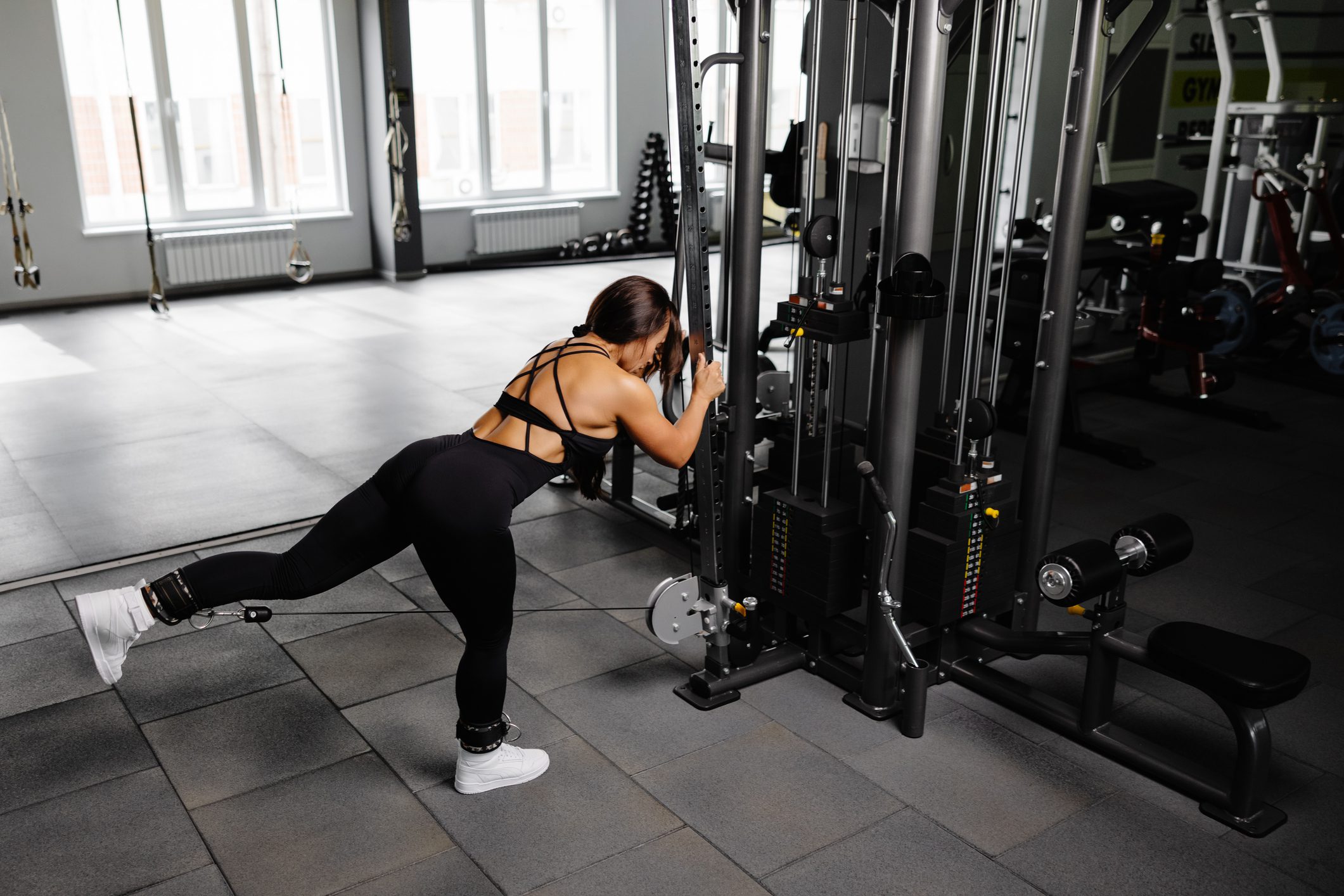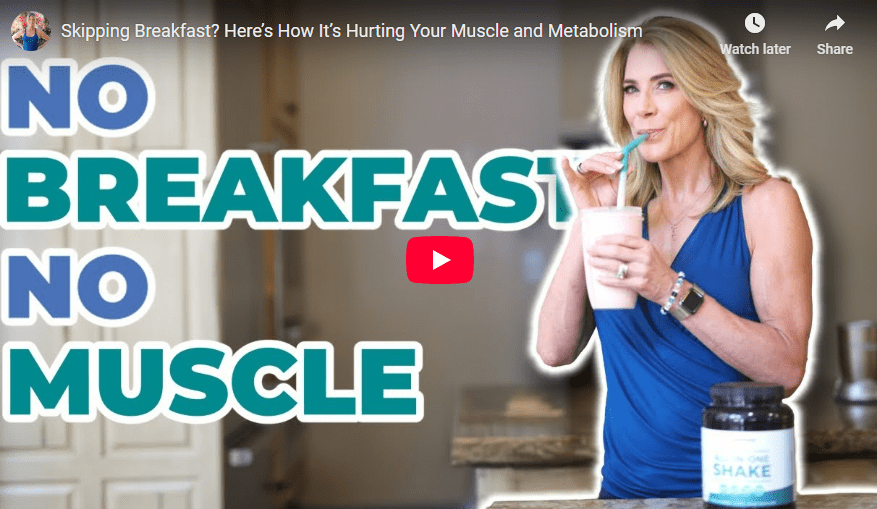Your body undergoes various changes with age that can impact overall health and well-being. Bone loss, decreased mobility, and joint issues can significantly affect your quality of life. Muscle loss contributes to many of these changes.1
While losing muscle mass and strength may be common with aging, it isn’t inevitable. Research consistently shows that resistance training, eating protein first, prioritizing rest and recovery, and other factors can preserve muscle mass and promote overall well-being regardless of age.2
With the right approach and proactive lifestyle choices, it’s never too late—or too early—to optimize muscle health and preserve strength and vitality.
How Muscle Loss Impacts Your Health
Sarcopenia is the progressive loss of muscle mass, strength, and functionality with aging. This condition can impair mobility, increase your risk of falls and fractures, and diminish your overall quality of life.3
This causes a substantial burden as you get older. One review examined 4,425 individuals (average age: 70) and found sarcopenia was prevalent in almost 45% of men and over 30% of women.4 Several factors contribute to this muscle loss, including:
- Physical inactivity
- Obesity
- Chronic diseases such as diabetes
- Insulin resistance
- Hormonal imbalances
- Insufficient protein intake 5
As muscle mass decreases, you might encounter symptoms like weakness, fatigue, reduced stamina, and a decline in physical performance. These changes can take away from your ability to perform everyday tasks and maintain independence.
The risk of sarcopenia increases during menopause. Why? Because estrogen supports muscle growth and maintenance. This hormone also helps maintain bone density, reducing your risk of osteoporosis and fractures.
During menopause, a drop in estrogen levels can accelerate the loss of muscle mass.6 This can lead to reduced strength, impaired mobility, and a heightened risk of injuries.
The good news is that many risk factors for sarcopenia are within your control, and building muscle is the best place to start. Regular resistance training is key to aging powerfully and effectively managing various age-related conditions.
The Benefits of Building Muscle With Age
Prioritizing building muscle offers many benefits beyond physical appearance. Building muscle is crucial for maintaining strength, vitality, and overall well-being for many reasons:
- Better physical ability: Muscle is the cornerstone of strength and vitality, allowing you to tackle everyday tasks easily and confidently. From effortlessly lifting heavy grocery bags to hoisting a carry-on into the overhead compartment on a plane, preserving muscle mass empowers you to maintain independence and mobility.7
- Accelerated recovery: Building and maintaining muscle can help you recover faster from surgeries, accidents, and injuries.8
- Healthy metabolism: Muscle is an active tissue that regulates metabolism and body composition. By cultivating lean muscle mass, you can effectively manage weight and enhance metabolic health, reducing your risk of obesity, insulin resistance, and related chronic diseases.9
- Healthy bones and joints: Strong muscles support and protect your bones and joints.10 By bearing the brunt of daily movements and activities, muscles help alleviate strain, reducing your risk of fractures, osteoporosis, and degenerative joint conditions.
- Mental health: Building muscle can instill confidence and well-being. A stronger, more resilient physique can give you a renewed sense of self-assurance and empowerment. Muscle can also support brain health and mental clarity as you age.11
How Muscle Helps Reverse Aging
Muscle tissue contributes significantly to hormone balance and metabolic health, which are crucial for aging powerfully. Maintaining muscle mass becomes increasingly important as you age for regulating hormones and sustaining a healthy metabolism.
Muscle Supports Hormone Health
Building and maintaining muscle supports the hormones that impact aging, including:
- Growth hormone (GH): GH supports muscle repair and growth, promotes cell regeneration, fosters healthy growth and renewal of cells, and helps build and repair muscle tissue.12
- Insulin-like growth factor 1 (IGF-1): IGF-1 works with GH to support muscle growth and repair. This potent hormone helps rejuvenate cells and fosters the development and maintenance of lean muscle mass.13
- Testosterone: Testosterone isn’t just for men. Women have small amounts of this hormone, which contributes to the growth and repair of muscle tissue.14
- Estrogen: Estrogen helps repair and regenerate muscle tissue, leading to quicker recovery following an injury or after a strenuous workout.15
- Cortisol: Resistance training helps your body become more efficient at managing this stress hormone. This results in more balanced cortisol release, even when you’re stressed out. Resistance training teaches your body to handle and recover from physical stressors more effectively.16
- Mood hormones: Resistance training impacts the release of hormones such as endorphins and serotonin.17, 18 These hormones elevate your mood and nurture a positive outlook.
Muscle Helps Maintain a Healthy Metabolism
Metabolic health becomes increasingly crucial for maintaining vitality, preventing chronic diseases (such as diabetes and heart disease), and preserving functional independence and quality of life as you age. Among the ways muscle supports your metabolism include:
- Blood-sugar regulation: Muscle enhances insulin sensitivity, which is crucial for glucose regulation. Regular resistance training improves muscle responsiveness to insulin, facilitating efficient glucose absorption. This reduces the risk of insulin resistance, which can lead to type 2 diabetes.19
- Fat metabolism: Building and maintaining muscle can promote a healthy lipid profile and lower the risk of heart disease. That’s because muscle regulates cholesterol and lipid metabolism. Your muscle cells metabolize fatty acids, aiding the breakdown of unhealthy fats, including triglycerides.20
- A healthy body weight: Muscle elevates your basal metabolic rate (BMR), the energy your body uses at rest for essential functions. As metabolically active tissue, muscle requires energy even during rest, so you burn more calories. This heightened BMR promotes favorable changes in body composition, such as preserving muscle and reducing body fat, helping you maintain a healthy weight.21
Muscle Supports Your Cell’s Energy Production
Muscle supports the energy production within your cells. Mitochondria, often called your cells’ powerhouses, are pivotal for energy generation and cellular vitality. Regular resistance training can optimize mitochondrial function, ensuring efficient energy production to support the numerous functions your cells carry out.22
Muscle Helps Manage Inflammation and Free-Radical Damage
Muscle helps manage chronic inflammation and combat free-radical damage, pivotal factors in aging. Chronic inflammation and oxidative stress accelerate cellular aging and contribute to age-related diseases. Resistance training positively influences your body’s inflammatory response, lowering inflammation levels and bolstering antioxidant defense mechanisms to fight free radicals.23
How to Optimize Muscle to Age Powerfully
No matter where you currently stand in your muscle health journey, implementing a few carefully chosen strategies can significantly impact your ability to reverse the effects of aging. Whether you’re just starting or looking to refine your existing approach, these strategies offer a roadmap for maximizing muscle health and vitality as you age.
- Eat protein first: Eating 30-50 grams of protein at every meal provides your muscles with the essential building blocks they need for growth and repair.24
- Incorporate resistance training: Consistent resistance training stimulates muscle growth, enhances strength, and improves endurance.25 This free Resistance Training Cheat Sheet provides everything you need for your fitness journey, including home gym essentials, an eight-week workout plan, and a progress tracker to track your sets, reps, and weights with each workout.
- Get muscle-supporting nutrients: Providing nutrients, including essential amino acids (EAAs) and creatine, helps build and maintain muscle and enhances performance during workouts.*26, 27
- Prioritize quality sleep: Poor sleep can increase stress levels, create hormone imbalances, and inhibit muscle-supporting pathways, leading to muscle loss and hindering recovery.28 Get eight hours of quality, uninterrupted sleep every night for muscle repair and growth. A well-designed supplement with melatonin and other sleep-supporting nutrients can help you fall and stay asleep safely.*
- Manage stress: Meditation, deep breathing exercises, or yoga can help you manage the detrimental effects of chronic stress that can impair muscle development.29
Feel Confident You’re Getting Enough Protein at Every Meal
Getting the right amount of protein can optimize muscle protein synthesis, the process by which the body rebuilds muscle tissue. This becomes increasingly important with age because muscle mass naturally decreases.
The 7-Day Eat Protein First Challenge makes hitting your protein quota simple at every meal. You’ll get a protein calculator (to see how much protein you should be getting) and a guide with tips, tricks, and a protein-first meal plan that help you successfully move toward getting the many benefits of protein.
Protein is the foundation for building muscle and preventing the negative impacts of aging. The 7-Day Eat Protein First Challenge gives you everything you need to confidently ensure 30-50g of protein at every meal.
Learn more and download your guide here.
References:
- Padilla Colón CJ, Molina-Vicenty IL, Frontera-Rodríguez M, García-Ferré A, Rivera BP, Cintrón-Vélez G, Frontera-Rodríguez S. Muscle and Bone Mass Loss in the Elderly Population: Advances in diagnosis and treatment. J Biomed (Syd). 2018;3:40-49. doi: 10.7150/jbm.23390. PMID: 30505650; PMCID: PMC6261527.
- Harvard Health: Preserve your muscle mass
- ScienceDirect: Sarcopenia – an overview
- Hwang J, Park S. Gender-Specific Risk Factors and Prevalence for Sarcopenia among Community-Dwelling Young-Old Adults. Int J Environ Res Public Health. 2022 Jun 13;19(12):7232. doi: 10.3390/ijerph19127232. PMID: 35742480; PMCID: PMC9223381.
- Cleveland Clinic: Sarcopenia (Muscle Loss): Symptoms & Causes
- Cho EJ, Choi Y, Jung SJ, Kwak HB. Role of exercise in estrogen deficiency-induced sarcopenia. J Exerc Rehabil. 2022 Feb 24;18(1):2-9. doi: 10.12965/jer.2244004.002. PMID: 35356136; PMCID: PMC8934617.
- National Institute on Aging: How can strength training build healthier bodies as we age?
- Liu J, Saul D, Böker KO, Ernst J, Lehman W, Schilling AF. Current Methods for Skeletal Muscle Tissue Repair and Regeneration. Biomed Res Int. 2018 Apr 16;2018:1984879. doi: 10.1155/2018/1984879. PMID: 29850487; PMCID: PMC5926523.
- National Institutes of Health: Healthy Muscles Matter: Ways to Care for the Muscular System
- Chikani V, Ho KK. Action of GH on skeletal muscle function: molecular and metabolic mechanisms. J Mol Endocrinol. 2013 Dec 19;52(1):R107-23. doi: 10.1530/JME-13-0208. PMID: 24163428.
- Ahmad SS, Ahmad K, Lee EJ, Lee YH, Choi I. Implications of Insulin-Like Growth Factor-1 in Skeletal Muscle and Various Diseases. Cells. 2020 Jul 24;9(8):1773. doi: 10.3390/cells9081773. PMID: 32722232; PMCID: PMC7465464.
- Gharahdaghi N, Phillips BE, Szewczyk NJ, Smith K, Wilkinson DJ, Atherton PJ. Links Between Testosterone, Oestrogen, and the Growth Hormone/Insulin-Like Growth Factor Axis and Resistance Exercise Muscle Adaptations. Front Physiol. 2021 Jan 15;11:621226. doi: 10.3389/fphys.2020.621226. PMID: 33519525; PMCID: PMC7844366.
- Tiidus PM. Benefits of estrogen replacement for skeletal muscle mass and function in post-menopausal females: evidence from human and animal studies. Eurasian J Med. 2011 Aug;43(2):109-14. doi: 10.5152/eajm.2011.24. PMID: 25610174; PMCID: PMC4261347.
- Harvard Health: Exercising to Relax – Harvard Health Publishing
- Mayo Clinic: Exercise and stress: Get moving to manage stress
- Young SN. How to increase serotonin in the human brain without drugs. J Psychiatry Neurosci. 2007 Nov;32(6):394-9. PMID: 18043762; PMCID: PMC2077351.
- Merz KE, Thurmond DC. Role of Skeletal Muscle in Insulin Resistance and Glucose Uptake. Compr Physiol. 2020 Jul 8;10(3):785-809. doi: 10.1002/cphy.c190029. PMID: 32940941; PMCID: PMC8074531.
- Morales PE, Bucarey JL, Espinosa A. Muscle Lipid Metabolism: Role of Lipid Droplets and Perilipins. J Diabetes Res. 2017;2017:1789395. doi: 10.1155/2017/1789395. Epub 2017 Jun 6. PMID: 28676863; PMCID: PMC5476901.
- McPherron AC, Guo T, Bond ND, Gavrilova O. Increasing muscle mass to improve metabolism. Adipocyte. 2013 Apr 1;2(2):92-8. doi: 10.4161/adip.22500. PMID: 23805405; PMCID: PMC3661116.
- Porter C, Reidy PT, Bhattarai N, Sidossis LS, Rasmussen BB. Resistance Exercise Training Alters Mitochondrial Function in Human Skeletal Muscle. Med Sci Sports Exerc. 2015 Sep;47(9):1922-31. doi: 10.1249/MSS.0000000000000605. PMID: 25539479; PMCID: PMC4478283.
- El Assar M, Álvarez-Bustos A, Sosa P, Angulo J, Rodríguez-Mañas L. Effect of Physical Activity/Exercise on Oxidative Stress and Inflammation in Muscle and Vascular Aging. Int J Mol Sci. 2022 Aug 5;23(15):8713. doi: 10.3390/ijms23158713. PMID: 35955849; PMCID: PMC9369066.
- Better Health Channel: Protein
- Better Health Channel: Resistance training
- Cleveland Clinic: Creatine: What It Does, Benefits, Supplements & Safety
- Dattilo M, Antunes HK, Medeiros A, Mônico Neto M, Souza HS, Tufik S, de Mello MT. Sleep and muscle recovery: endocrinological and molecular basis for a new and promising hypothesis. Med Hypotheses. 2011 Aug;77(2):220-2. doi: 10.1016/j.mehy.2011.04.017. Epub 2011 May 7. PMID: 21550729.
*These statements have not been evaluated by the Food & Drug Administration. Products mentioned are not intended to diagnose, treat, cure, or prevent any disease. The views in this blog by JJ Virgin should never be used as a substitute for professional medical advice. Please work with a healthcare practitioner concerning any medical problem or concern.





